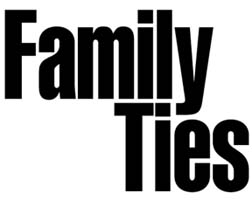Advertisement - Click to support our sponsors.



By Nadine Kam
Star-Bulletin
THE parents screwed up. In trying to protect their children from evil spirits, parents in China and Japan dressed them in clothes so exquisite and adorable, any demon of the human sort would have wanted to snatch them away, or at the least, grab them and hug them.The practice has left us with a legacy of children's ceremonial costumes on view at the Honolulu Academy of Arts. The exhibition, "Family Ties in Asian Textiles: Children's and Adult Costumes from Japan and China," opens today, with 140 examples of child and adult apparel dating from the late 19th century to mid-20th century.
"Traditional Asian societies believed prosperity to come from long blood lines and having many children," said Reiko Brandon, textile curator for the academy. "But the mortality rate was extremely high through the early 20th century because of poor hygiene and sanitation and lack of medical facilities. So they relied on rituals carried on from birth to the time the child became an adult to ensure the child's good fortune and longevity."

The costumes reflected cultural and religious beliefs and family traditions, she said. In Japan, newborns were considered unstable and impure. The child was wrapped in rags or swaddling clothes made from the mother's old clothing. After seven days, the swaddling clothes were discoarded for a ceremonial kimono presented by its maternal grandmother. The child would then be given a name that ensured his or her entry to the world."There's also a very old tradition in Japan," Brandon said, "in which a child -- born to a family that has experienced misfortune, or a recent death -- is placed temporarily at the front gate of a family that is wealthier or happier, to reverse the bad luck.
"In China, for a child's first birthday, they would dress him up put him in the midst of objects and let him pick one, which would then suggest his future profession. Picking up a calligraphy brush might indicate a scholar."

The ritual costumes bore auspicious patterns and intriguing motifs "that you never see on adult costumes," Brandon said.Among these are semamori, a sort of tassel sewn to the bottom of the back of childrens' kimono in Japan. It was a fashionable equivalent to a leash.
"It was symbolic as a way for parents to hold their child down safely so evil spirits could not take them away," said Brandon.
Other auspicious motifs for Japanese girls included cherry blossoms, peonies and chrysanthemums, while boys' costumes depicted scenes of battling samurai, Japanese soldiers on horseback and animal images symbolic of power and strength.
In China also, hats and caps bore three-dimensional appliqued and embroidered images of tigers and dogs, that Brandon described as "poignant."
"I hate to use the word 'cute,' but they were. The images were not at all frightening or fierce, even though they were meant to represent a magical power that would chase away evil spirits."
Under the hat was usually a boy. "In Asia, people loved to have many children, but they mostly loved boys," Brandon said. "It was the boy that brought fame, wealth and status to families.
"I just recently saw some magazines in which girls were wearing tiger hats, but in the early 20th century this was not the case."
While in the west, children's clothes are often cheaply made, small-scale copies of adult clothing, the same was not true in Asia.

"In general, not counting the most exceptional of adult costumes, childrens' costumes in Asia were not poor replicas of adult costumes. They were wonderful and even better in terms of materials and craftsmanship."Included in the show will be some adult costumes for comparison.
Costumes that are not included in the show, which Brandon wishes people could see, are the Chinese Hundred Families Robe and its Japan equivalent, the Hundred Virtue Robe. It is pieced together by a child's mother from small fragments of quilts made by a symbolic hundred different families. Each little patch represents the families' good fortune.
"I've seen these in a couple of pictures and I wish we had one of them in our collection," Brandon said.
There are 140 items in the show, with 50 garments from Japan and 90 garments from China, including Manchu courtiers' robes, a Manchu emperor's dragon robe and Han garments. Garments were drawn from the academy's collections and the California-based Christensen Fund, a collection 1,500 costumes from seven Asian and Southeast Asian cultures.
"Some were very sophisticated, particularly the Japanese kimono made by professional weavers and dyers. The elite costumes were delicate, shimmery and shiny, with intricate woven patterns," Brandon said.
But equally impressive were the costumes sewn by mothers, grandmothers and aunts. "The ethnic costumes of the Miao people were homemade and wonderful. These were made from cotton and silk. The silk was very earthy, hand-woven and hand-dyed, with simple patterns.
"It's very poignant, even though it's supposed to be frightening. They're so beautiful and cute, you can't help smiling."
On view
What: "Family Ties in Asian Textiles: Children's and Adult Costumes from Japan and China"
Dates: 10 a.m. to 4:30 p.m. Tuesdays to Saturdays and 1 to 5 p.m. Sundays through Feb. 18
Place: Honolulu Academy of Arts
Admission: $7 general; $4 seniors, students and military; free for members and keiki under 12
Call: 532-8700
Also: "Keiki-Parent Activity Tour" 9 to 11 a.m. Jan. 13 for keiki ages 6 to 12 and their parents. Following the tour of "Family Ties in Asian Textiles" exhibition, keiki will create their own hats. Free, but reservations required. Call 532-8726.
Click for online
calendars and events.